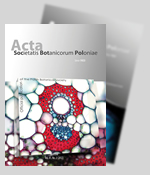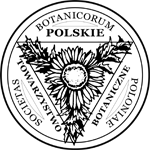Micromorphology of the epidermis and anatomical structure of the leaves of Scorzonera hispanica L.
Abstract
Keywords
Full Text:
PDFReferences
Lack HW. Compositae. Tribe Cichorieae Lam. & DC. In: Kubitzki K, editor. The families and genera of vascular plants. Berlin: Springer-Verlag; 2007. p. 180–199.
Szweykowska A, Szweykowski J. Słownik botaniczny. Warszawa: Wiedza Powszechna; 1993.
Rejewski M. Pochodzenie łacińskich nazw roślin polskich: przewodnik botaniczny. Warszawa: Książka i Wiedza; 1996.
Mirek Z, Piękoś-Mirkowa H, Zając A, Zając M, editors. Flowering plants and pteridophytes of Poland – a checklist. Kraków: W. Szafer Institute of Botany, Polish Academy of Sciences; 2002. (Biodiversity of Poland; vol 1).
Rutkowski L. Klucz do oznaczania roślin naczyniowych Polski Niżowej. 2nd ed. Warszawa: Wydawnictwo Naukowe PWN; 2005.
Nuez F, Bermejo JEH. Neglected crops: 1492 from a different perspective. In: Bermejo JEH, León J, editors. Plant production and protection series No. 26. FAO: Rome; 1994. p. 303–332.
Podbielkowski Z, Sudnik-Wójcikowska B. Słownik roślin użytkowych. 7th ed. Warszawa: Powszechne Wydawnictwo Rolnicze i Leśne; 2003.
Chaux C, Foury C. Scorzonere ou salsify noir. Productions legumieres. Techniques et Documentation – Lavoisier. 1994;2:443–451.
Douglas J. Scorzonera hispanica – a European vegetable. [Internet]. Crop and Food Res. 2005 [cited 2005 Mar 28]; Available from: http://www.crop.cri.nz/home/products-services/publications/broadsheets/028scorzonera.Pdf
Bosch CH. Scorzonera hispanica L. In: Grubben GJH, Denton OA, editors. Plant resources of tropical Africa. 2. Vegetables. Wageningen: PROTA Foundation, Backhuys Publishers, CTA; 2004. p. 454–455.
Dolota A, Dąbrowska B. The nutritive value of the leaves of several scorzonera (Scorzonera hispanica L.) cultivars. Fol Univ Agric Stetin Agric. 2004;239(95):63–68.
Dolota A, Dąbrowska B. Raw fibre and inulin content in roots of different scorzonera cultivars (Scorzonera hispanica L.) depending on cultivation method. Folia Hortic. 2004;16(1):31–37.
Konopiński M. Influence of intercrop plants and varied tillage on yields and nutritional value of scorzonera (Scorzonera hispanica L.) roots. Acta Sci Pol Hortorum Cultus. 2011;10(1):49–59.
Bryanskii OV, Tolstikhina VV, Zinchenko SV, Semenov AA. A sesquiterpene glucoside from cultivated cells of Scorzonera hispanica. Chem Nat Compd. 1992;28(6):556–560. http://dx.doi.org/10.1007/BF00630429
Zidorn C, Ellmerer-Müller EP, Stuppner H. Sesquiterpenoids from Scorzonera hispanica L. Pharmazie. 2000;55:550–551.
Granica S, Lohwasser U, Jöhrer K, Zidorn C. Qualitative and quantitative analyses of secondary metabolites in aerial and subaerial of Scorzonera hispanica L. (black salsify). Food Chem. 2015;173:321–331. http://dx.doi.org/10.1016/j.foodchem.2014.10.006
Bryanskii OV, Tolstikhina VV, Semenov AA. A glycoside of syringaresinol from a tissue culture of Scorzonera hispanica. Chem Nat Compd. 1992;28(5):519–520. http://dx.doi.org/10.1007/BF00630677
Niness KR. Inulin and oligofructose: what are they? J Nutr. 1999;129:1402–1406.
Flamm G, Glinsmann W, Kritchevsky D, Prosky L, Roberfroid M. Inulin and oligofructose as dietary fibre: a review of the evidence. Crit Rev Food Sci. 2001;41(5):353–362. http://dx.doi.org/10.1080/20014091091841
Kelly G. Inulin-type prebiotics: a review (part 1). Altern Med Rev. 2008;13(4):315–329.
Kelly G. Inulin-type prebiotics: a review (part 2). Altern Med Rev. 2009;14(1):36–55.
Nowak A, Klimowicz A, Bielecka-Grzela S, Piechota M. Inulin: a valuable nutritional component. Ann Acad Med Stetin. 2012;58(1):62–65.
Balcazar-Munoz BR, Martinez-Abundis E, Gonzalez-Ortiz M. Effect of oral inulin administration on lipid profile and insulin sensitivity in subjects with obesity and dyslipidemia. Rev Med Chil. 2003;131:597–604.
Coudray C, Bellanger J, Castiglia-Delavaud C, Rémésy C, Vermorel M, Rayssignuier Y. Effect of soluble or partly soluble dietary fibres supplementation on absorption and balance of calcium, magnesium, iron, and zinc in healthy young men. Eur J Clin Nutr. 1997;51:375–380. http://dx.doi.org/10.1038/sj.ejcn.1600417
Kim YY, Jang KH, Lee EY, Cho Y, Kang SA, Ha WK, et al. The effect of chicory fructan fiber on calcium absorption and bone metabolism in Korean postmenopausal women. Nutr Sci. 2004;7:151–157.
Khobrakova VB, Nikolaev SM, Tolstikhina VV, Semenov AA. Immunomodulating properties of lignan glucoside from cultivated cells of Scorzonera hispanica L. Pharm Chem J. 2003;37:10–11. http://dx.doi.org/10.1023/A:1026359206059
Vulsteke G, Calus A. Influence of variety, date of harvest and storage time on factors connected with the crystallization on canned scorzonera (Scorzonera hispanica). Plant Foods Hum Nutr. 1990;40:149–166. http://dx.doi.org/10.1007/BF02193773
Wędzony M. Mikroskopia fluorescencyjna dla botaników. Kraków: Zakład Fizjologii Roślin im. Franciszka Górskiego, Polska Academia Nauk; 1996. (Monografie; vol 5).
Nevalainen JJ, Laitio M, Lindgren I. Periodic acid-schiff (PAS) staining of epon-embedded tissues for light microscopy. Acta Histochem. 1972;42:230–233.
Broda B. Metody histochemii roślinnej. Warszawa: Państwowy Zakład Wydawnictw Lekarskich; 1971.
Meidner H, Mansfield TA. Physiology of stomata. London: McGraw-Hill; 1968.
Kilian N, Gemeinholzer B, Lack HW. Cichorieae. In: Funk VA, Susanna A, Stuessy TF, Bayer RJ, editors. Systematics, evolution and biogeography of Compositae. Vienna: International Association for Plant Taxonomy; 2009. p. 343–383.
Makbul S, Turkmen Z, Çoşkunçelebi K, Beyazoğlu O. A morphometric study on Scorzonera L. taxa (Asteraceae) from northeast Anatolia. Acta Bot Croat. 2010;69(2):237–247.
Stace CA. The taxonomic importance of leaf surface. In: Heywood VH, Moore DM, editors. Current concepts in plant taxonomy. London: Academic Press; 1984. p. 67–94.
Budel JM, Duarte M, Santos C. Stem morpho-anatomy of Baccharis cylindrical (Less.) DC. (Asteraceae). Braz J Pharm Sci. 2004;40(1):93–99. http://dx.doi.org/10.1590/S1516-93322004000100014
Adedeji O, Jewoola OA. Importance of leaf epidermal characters in Asteraceae family. Not Bot Hort Agrobot Cluj. 2008;36(2):7–16.
Amorin M, de Paula JP, da Silva RZ, Farago PV, Budel JM. Pharmacobotanical study of the leaf and stem of Mikania lanuginosa for its quality control. Rev Bras Farmacogn. 2014;24:531–537. http://dx.doi.org/10.1016/j.bjp.2014.10.002
Uzunova K, Bancheva S, Raimondo FM. Studies on the leaf epidermal structure of genus Cyanus, sect. Napuliferae (Compositae). Bocconea. 2007;21:249–256.
Kolattukudy PE, Rogers LM, Li D, Hwang CS, Flaishman MA. Surface signaling in pathogenesis. Proc Natl Acad Sci USA. 1995;92:4080–4087. http://dx.doi.org/10.1073/pnas.92.10.4080
Mendgen K. Fungal attachment and penetration. In: Kerstiens G, editor. Plant cuticles. Oxford: Bios Scientific Publishers; 1996. p. 175–188.
Schreiber L, Krimm U, Knoll D, Sayed M, Auling G, Kroppenstedt RM. Plant microbe interactions: identification of epiphytic bacteria and their ability to alter leaf surface permeability. New Phytol. 2005;166:589–594. http://dx.doi.org/10.1111/j.1469-8137.2005.01343.x
Kurdyukov S, Faust A, Nawrath C, Bär S, Voisin D, Efremova N, et al. The epidermis-specific extracellular bodyguard controls cuticle development and morphogenesis in Arabidopsis. Plant Cell. 2006;18(2):321–339. http://dx.doi.org/10.1105/tpc.105.036079
Wu R, Li S, He S, Wassmann F, Yu C, Qin G. CFL1, a WW domain protein, regulates cuticle development by modulating the function of HDG1, a class IV homeodomain transcription factor, in rice and Arabidopsis. Plant Cell. 2011;23(9):3392–3411. http://dx.doi.org/10.1105/tpc.111.088625
Makbul S, Çoşkunçelebi K, Gültepe M, Okur S, Güzel ME. Scorzonera ahmet-duranii sp. nov. (Asteraceae) from southern Anatolia, and its phylogenetic position. Nord J Bot. 2012;30:2–11. http://dx.doi.org/10.1111/j.1756-1051.2011.01235.x
Makbul S, Turkmen Z, Çoşkunçelebi K, Beyazoğlu O. Comparison of foliar anatomy of Scorzonera L. (Asteraceae) taxa form north east Anatolia. Pak J Bot. 2011;43(1):135–155.
Çoşkunçelebi K, Makbul S, Gültepe M, Onat D, Güzel M, Okur S. A new Scorzonera (Asteraceae) species from South Anatolia, Turkey, and its taxonomic position based on molecular data. Turk J Bot. 2012;36:299–310. http://dx.doi.org/10.3906/bot-1104-20
Qureshi SJ, Khan MA, Ahmad M. Comparative morphology, palynology and anatomy of five astraceous species from Pakistan. Afr J Agric Res. 2008;3(9):622–632.
Cutler DF, Brandham PE. Experimental evidence for genetic control of leaf surface characters in hybrid Aloinaeae. Kew Bull. 1978;32:23–32. http://dx.doi.org/10.2307/4117256
Hodgson JG, Sharafi M, Jalili A, Dýaz S, Montserrat-Martý G, Palmer C, et al. Stomatal vs. genome size in angiosperms: the somatic tail wagging the genomic dog? Ann Bot. 2010;105:573–584. http://dx.doi.org/10.1093/aob/mcq011
Pearce DW, Millard S, Bray DF, Rood SB. Stomatal characteristics of riparian popular species in a semi-arid environment. Tree Physiol. 2006;26:211–218. http://dx.doi.org/10.1093/treephys/26.2.211
Casson S, Gray JE. Influence of environmental factors on stomatal development. New Phytol. 2008;178(1):9–23. http://dx.doi.org/10.1111/j.1469-8137.2007.02351.x
Adedeji O. Leaf epidermal studies of the species of Emilia Cass. (Senecioneae, Asteraceae) in Nigeria. Bot Lith. 2004;10(2):121–133.
Qi XP, Zhang XC. Taxonomic revision of Lepisorus (J. Sm.) Ching sect. Lepisorus (Polypodiaceae) from China. J Syst Evol. 2009;47(6):581–598. http://dx.doi.org/10.1111/j.1759-6831.2009.00056.x
Leroux O. Collenchyma: a versatile mechanical tissue with dynamic cell walls. Ann Bot. 2012;110(6):1083–1098. http://dx.doi.org/10.1093/aob/mcs186
Aydin Ö, Çoşkunçelebi K, Gültepe M, Güzel ME. A contribution to taxonomy of Centaurea including Psephellus (Asteraceae) based on anatomical and molecular data. Turk J Bot. 2013;37:419–427. http://dx.doi.org/10.3906/bot-1204-25
Wojtaszek P, Woźny A, Ratajczak L. Biologia komórki roślinnej. T.1. Struktura. Warszawa: Wydawnictwo Naukowe PWN; 2012.
Woźny A, Michejda J, Ratajczak L, editors. Podstawy biologii komórki roślinnej. Poznań: Wydawnictwo naukowe Uniwersytetu im. Adama Mickiewicza w Poznaniu; 2000.
Hejnowicz Z. Anatomia i histogeneza roślin naczyniowych. Warszawa: Wydawnictwo Naukowe PWN; 2002.
DOI: https://doi.org/10.5586/asbp.2015.033
|
|
|







